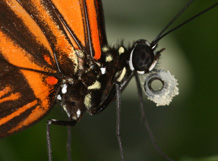
Image courtesy of: Professor Chris Jiggins, Department of Zoology, University of Cambridge.
Genetic switch that turned moths black also colours butterflies
The same gene that enables tropical butterflies to mimic each other’s bright and colourful patterning also caused British moths to turn black amid the grime of the industrial revolution, researchers have found.
Writing in the journal Nature, a team of researchers including Professor Richard Ffrench-Constant, based at the University of Exeter’s Penryn Campus, report that a gene known as “cortex” appears to play a critical role in dictating the colours and patterns on butterfly wings.
A parallel paper in the same journal shows that this same gene also caused the peppered moth to turn black during the mid-19th century, when it evolved to find new ways to camouflage itself; a side-effect of industrial pollution at the time.
The research, co-led by the universities of Exeter, Sheffield and Cambridge, offers clues about how genetics play a role in making evolution a predictable process. For reasons the researchers have yet to understand in full, the cortex gene, which helps to regulate cell division in butterflies and moths, has become a major target for natural selection acting on colour and pattern on the wings.
Professor Richard Ffrench-Constant, of the University of Exeter, said: “It's incredible to think that the gene that colours butterfly wings to advertise that they are bad to eat is the same gene as that responsible for industrial melanism, where moths turn black to hide on soot-blackened backgrounds.”
Professor Chris Jiggins, of the University of Cambridge, is one of the study’s lead authors. He said: “Something about how the colours on a butterfly wing are made means that this gene has been targeted by evolution. It raises the question that given the diversity in butterflies and moths, and the hundreds of genes involved in making a wing, why is it this one every time?”
Butterflies and moths comprise the order of insects known as Lepidoptera. Nearly all of the 160,000 types of moth and 17,000 types of butterfly have different wing patterns, which are adapted for purposes like sexual signalling, giving off warnings, the avoidance of detection by other animals (known as “crypsis”), and thermal regulation.
These wing patterns are actually made up of an array of tiny coloured scales. Although they have been studied by biologists for over a century, the molecular mechanisms which control their development are only now starting to be uncovered.
The peppered moth is perhaps the most famous example of evolution by natural selection occurring in an insect’s wing pattern. Until the 19th Century, peppered moths were predominantly pale-coloured, and used this to camouflage themselves against lichen-covered tree trunks, which made them almost invisible to predators.
During the industrial revolution, however, the lichen on trees in some parts of the country was killed by pollution, and soot turned the trunks black. At some point during the mid-1800s, a mutation arose in peppered moths which caused them to turn black as well, helping them to remain camouflaged from birds. The process is known as industrial melanism – melanism meaning the development of dark coloured pigmentation.
The fact that this process was caused by the cortex gene only recently became clear thanks to a separate study focusing on peppered moths. Fascinatingly, however, the Cambridge-Sheffield study has now shown that exactly the same gene also influences the extremely bright and colourful patterns of Heliconius – the name given to about 40 different closely-related species of beautiful, tropical butterflies found in South America.
The study shows that cortex influences the development of bright yellow patches on the wings of different Heliconius species. These are used to send a signal to potential predators that the butterflies are toxic if eaten, and different types of Heliconius butterfly mimic one another by using the bright yellow as a warning signal. Unlike the dark colouring of the peppered moth, it is therefore an evolutionary development that is meant to be seen.
The researchers carried out fine-scale mapping of pattern variation in three different Heliconius species, and in each case the cortex gene was found to be responsible for this adaptation in their patterning. The cortex is turned on in parts of the wing that are destined to turn black.
Because Heliconius species are extremely diverse, the study of what causes variations in their patterning can provide more general clues about the genetic switches that control diversification in species.
In most cases, the genes responsible for these processes are known as “transcription factors” – meaning that they are responsible for turning other genes on and off. Intriguingly, what made cortex such an elusive switch to spot was the fact that it does not do this. Instead, it is a cell cycle regulator, which means that it controls when cells divide and thus when different coloured scales develop within a butterfly wing.
“It’s a different gene to the one we might have expected and we still need to do more to understand exactly what it’s doing, and how it’s doing it,” Jiggins said. “It raises some very interesting questions. If all of these genes are interacting, is there something about the shape of those genetic networks, or the ways in which the wings are constructed, that means there are particular points in the process at which new patterns can be generated?”
The study, A major gene controls mimicry and crypsis in butterflies and moths, is reported in Nature.
Date: 3 June 2016
